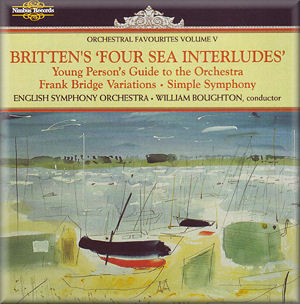 |
 |
| 
Buy
through MusicWeb
for £9.50 postage paid World-wide.
Musicweb
Purchase button
Sound Samples and Downloads |
Benjamin BRITTEN
(1913-1976)
The Young Person’s Guide to the Orchestra, Op.34* [16.42]
Four Sea Interludes from Peter Grimes, Op.33a
[15.40]
Variations on a theme of Frank Bridge, Op.10 [25.24]
Simple Symphony, Op.4 [16.51]
 English Symphony Orchestra/William Boughton
English Symphony Orchestra/William Boughton
rec. Symphony Hall, Birmingham, 11-12 April 1991*; Great Hall, Birmingham
University, 30-31 March 1995
 NIMBUS NI 7017 [74.36]
NIMBUS NI 7017 [74.36]
|
|
|
One of the very first CD releases ever was Decca’s reissue of
Britten’s own recordings of the Young Person’s Guide
from a 1964 LP, the Frank Bridge Variations from 1967,
and a 1969 recording of the Simple Symphony given in
the Snape Maltings. These were indeed among Britten’s best recordings
of his own music. He was always a superb interpreter of his
works, even when sometimes the contributions of individual performers
were fallible. The recorded sound was, and remains, superb.
The CD under consideration here reduplicates the contents of
that release and adds the Sea Interludes, which Britten
himself never recorded except as part of his two complete readings
(audio and video) of Peter Grimes.
It has to be said that William Boughton’s performances, good
as they are, do not measure up to the composer’s. For a start
the recordings are much less ‘engineered’ – that is to say,
what we are given in the Young Person’s Guide is a
straightforward concert hall acoustic without any attempt to
bring the various solo instruments of the orchestra forward
into prominence. Britten’s scoring was invariably skilful, but
the highlighting given to, for example, the harp in his own
recording adds to our enjoyment by letting us hear all the detail
that is inevitably somewhat muffled in a ‘natural’ acoustic.
The violins in their polacca variation benefit from
the larger sound of Britten’s London Symphony Orchestra strings,
as opposed to what sounds like a somewhat smaller body in Birmingham.
Boughton attempts – with success – to match Britten’s hectic
speed for the final fugue, but the greater distance of the orchestral
sound means that the clarity of the writing is not as clearly
conveyed.
Some might indeed object that the English Chamber Orchestra
for Britten make too ‘beefy’ a sound in their highly
resonant recording of the Simple Symphony, but in the
recording under consideration here Boughton is much more polite,
much more laid-back in music which really should conjure up
the sheer joy of creation which we find in Britten’s reinvention
of music from his childhood. The playing in the Playful
pizzicato shows great skill, but the ECO strings for Britten
also find a sense of fun which nearly makes the listener forget
how annoyingly close the tune comes to the facile nursery rhyme
Girls and boys come out to play.
The English Chamber Orchestra featured again in Britten’s own
reading of the Frank Bridge Variations, but the slimmer
recorded sound they were given in 1967 is more evenly matched
by Boughton’s recording in the reverberant Birmingham acoustic.
The results are very comparable. Indeed Boughton’s strings are
a bit crisper in places, and he brings out the weird melancholy
of the Funeral march variation most effectively.
The main point of this compilation must be Boughton’s performance
of the Four Sea Interludes, which indeed are highlighted
as the principal item on the disc. Here Boughton is very relaxed,
treating the music as a series of miniature tone poems rather
than as part of a dramatic work. These are not easy pieces to
play, and the violins sound stretched to their limits both in
the high-lying cantilenas of Morning and the quicksilver
figuration of Sunday morning. Nor do they bring real
warmth to the initial statement of the tune associated in the
opera with Ellen’s “Glitter of waves”, so that the more etiolated
versions which follow do not form a real contrast. However Boughton
brings a nice sense of depth to the Moonlight movement,
which he keeps moving so that the sense of line is maintained;
at a slower speed this music can sometimes almost grind to a
halt. In the final Storm the natural balance of the
orchestra brings out the violence of the music, but there are
problems when the reverberation of the gong almost overwhelms
the woodwind in the opening phrases of the fast central section
(at 1.45). The sense of the principal line is sometimes obscured
elsewhere.
These are, therefore, good performances which one would be delighted
to encounter in the concert hall, and which will give listeners
a real sense of the overwhelming greatness of the music. That
said, in the end, Britten’s own performances made some twenty
years earlier bring a greater sense of conviction as well as
offering a recording that still sounds superb. Even in Boughton’s
Sea Interludes which Britten never recorded independently
- although there was at one time available a version which was
taken from the complete audio recording, including vocal passages
and fade-outs - there is a greater sense of dramatic involvement
to be found in other performances.
Paul Corfield Godfrey
|
|

